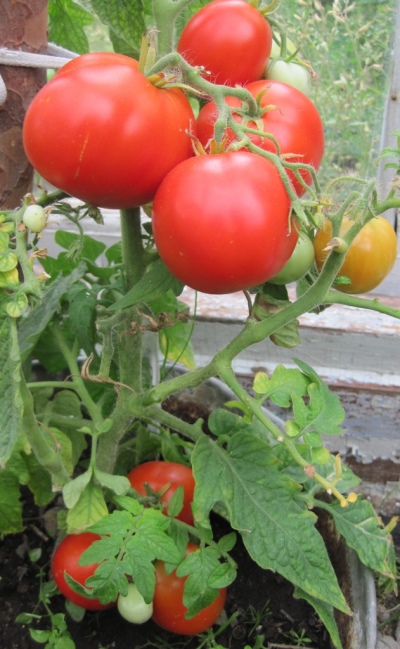
- Authors: Kozak V.I., Kononov A.N.
- Year of approval: 2007
- Category: grade
- Growth type: determinant
- Appointment: fresh consumption, for whole fruit preservation
- Ripening period: early
- Ripening time, days: 100-105
- Growing conditions: for open ground, for film greenhouses
- Bush size: undersized
- Bush height, cm: 45-60
The Far North tomato is very popular among summer residents. And this is no coincidence. After all, it was originally intended for cultivation, including in areas with risky farming. Therefore, if you grow it in a more favorable place, it shows itself to be quite unpretentious. For example, in the middle zone and more southern territories, it can be confidently planted immediately into the ground. The maximum that is needed is to cover it with a film material at the beginning of growing. And for beginners in growing tomatoes, this is a real find.
Breeding history
Tomato Far North was created on the basis of the St. Petersburg regional "Union of Seed Producers" and the Association "Biotekhnika". The breeding research took into account the peculiarities of the climate of all regions of the Russian Federation, and also carried out test cultivation almost everywhere, even in Siberia. This prompted to give the variety the name "Far North". Culture was entered into the State Register in 2007.
Description of the variety
The tomato bush of the considered variety is standard. Its root system is small. The growth point does not exceed 60 cm, which confirms the determinancy of the plant. The Far North has a strong leafy trunk. The size of the leaves is not very large, the color is deep green. Short inflorescences form up to 6 berries per cluster; the last of them is formed at the very top of the plant.
The main qualities of the fruit
In shape, the fruits of the Far North variety are weakly ribbed, and by weight they are 100 grams. But this - on the very first brushes, further brushes form tomatoes usually weighing no more than 60-80 grams.
The variety belongs to the medium-fruit category. However, a large number of seed chambers inside a tomato can be noted, or rather, 4-6.
When the tomatoes are not yet ripe, they will be the color of the so-called milky green. And when the full biological maturity of the berries comes, they become saturated red.
Taste characteristics
According to numerous reviews of those who have already tasted the Far North tomatoes, tomatoes have a completely traditional tomato flavor. However, the presence of sourness, despite the fact that it is weakly expressed, is not to everyone's liking.
Ripening and fruiting
The ripening terms of the Far North variety are referred to as early maturing. 100-105 days pass from sprouting to harvesting the first fruits.
Yield
Yields vary as the crop is grown in different regions. Therefore, a fairly average figure is 1.9 kg per sq. m.
The timing of planting seedlings and planting in the ground
Sowing schedule for seedlings of tomato seeds in the Far North - late March, early April. But the transfer of seedlings to the ground is carried out from late May to early June, depending on weather conditions.

Growing tomato seedlings is an extremely important process, because it largely depends on whether the gardener can harvest at all. All aspects must be taken into account, from seedbed preparation to planting in the ground.
Landing scheme
There are two fundamentally different approaches to how to grow tomatoes in the Far North:
- measured scheme - 40x60 cm;
- compacted planting - up to 8 bushes per 1 sq. m.

Growing and caring
The Far North is one of those varieties that can be grown both by seedling and non-seedling methods. With a seedless technique, seeds are sown directly into the ground, but under a film cover.
With the seedling method, the grown seedlings on the garden bed can be planted only in the last days of May. When used in growing a greenhouse, seedlings can be transferred to it a week earlier.
At the same time, you cannot plant tomatoes in places where nightshade crops, such as potatoes or peppers, as well as eggplants, grew last year.
In general, the Far North, like a tomato, is unpretentious to cultivation conditions. Nevertheless, in sunny places, the culture will grow better and bear fruit.




A plant needs different micronutrients at each stage of growth. All fertilizers can be divided into two groups: mineral and organic. Folk remedies are often used: iodine, yeast, bird droppings, eggshells.
It is important to observe the rate and period of feeding. This also applies to folk remedies and organic fertilizers.


Growing regions
As already mentioned, the Far North is grown not only in the north - there are many places where it is a welcome guest and feels good. In addition to the northern regions, these are the northwestern, as well as the Central Black Earth Region, Central, Volgo-Vyatka, Middle and Lower Volga, North Caucasian regions. And, of course, the Urals, Western and Eastern Siberia, the Far East.

























































































